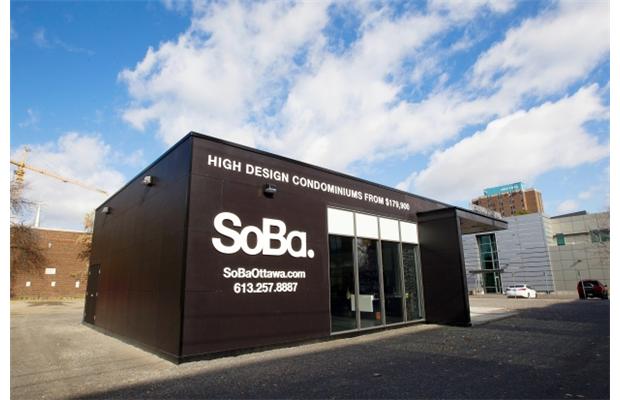
BY MARILYN WILSON, THE OTTAWA CITIZEN NOVEMBER 1, 2012

This is it! This is where I want to live. I’m home suite home. Why? Because this master suite is perfect. It’s sweeter than all the other suites.
Just look at the cove ceilings, the quarter sawn oak floors, the fabulous panelled and architecturally detailed wall treatments. It is gorgeous, clean, organized, but warm and inviting. The antique glass doors are sensational. There are curved walls and niches designed for display.
And in the bathroom are sleek and sophisticated tiles and sconces. The floors are heated so that I can step out of a piping hot shower and still be oblivious to -15 C weather outside. Not to mention, it looks like hardwood but is actually grey textured porcelain. But back to that shower; it looks divine — a glass steam shower with everything from a rain shower head to 12 jets.
Look up: 13-foot ceilings! What’s that? Oh, the ceilings are only that high because it’s the developer’s model. There will be other differences, too …
Be wary, condo buyer; the developer’s model suite may be sweeter than your suite. Why? One thing developers never skimp on is the model suite. They hire top designers to put together eye-catching megasuites to wow any buyer.
The idea is to make the prospective owner so excited about each feature — and this new lifestyle — that he or she will sign on the dotted line. People judge books by their covers, so why not condos by their models? Developers are very competitive about how they present the condo to the condo shopper.
I have written about space, volume and architectural details, but now I am offering shopping wisdom: When looking for a condo, make sure you are able to differentiate between the model suite and what your condo will actually look like.
Some things to look out for? Sometimes the model has 10-foot or higher ceilings, but the condo may in reality have 8.5 or nine-foot ceilings. Be careful not to feel a false sense of height and openness caused by this change in scale. So ask: Are the ceilings shown in the model suite the same height of what I will be getting in my condo?
Developers have no intention of tricking you in any way, it’s just that the showroom may be a makeshift loft, trailer or commercial space. The concept is to give you an idea of what you are buying, though your unit may not be exactly what you see here. This is very important for pre-sale condo buyers, especially those who intend to reside in the building, rather than those who are investors.
Another way you may get a false sense of openness is by viewing a model that has no doors between the rooms. While this may seem obvious, you may not notice this missing feature as you are simply passing through. An absence of dividers keeps the space open, making it appear much better and even more spacious. And which way will that door open when installed?
You may also find the model space feels larger because it’s de-cluttered. Remember that this is an uninhabited space so there is no teenager with clothes, dog with toys, husband with books or gadgets. So stop, look beneath the highly organized space and think about this: Where will your clutter go? And along with that, where is your storage space?
As far as price, remember that the model does not necessarily show the base costs; it may include upgrades. For instance, if you see crown mouldings and a beautiful panelled dining room (and you love both these features) do not choose the condo based on these things unless you know that they are not upgrades or, if they are, that you are willing to pay more for them.
Another part of knowing what you are paying for is knowing the square footage and how it is measured. Many condo developers will not write the exact square footage into the Agreement of Purchase and Sale. This is because, for pre-sale condos, they will plan and then maybe re-plan how much space is needed for the elevators and emergency staircases. Then they will plan and possibly re-plan the space for the comment elements. The square footage may change depending on these plans.
Remember, this measurement most always includes any balcony or balconies. The reason the square footage may be left off your contract is that, if an adjustment is made during building, you may end up with a foot or two less. The contract speaks to the idea of approximation and developers try their best to accommodate the square footage you have paid for.
Regardless of this number, get to know the space you are about to purchase. Will it work with your queen- or king-sized bed? Check out the size in the model. Make sure you are familiar enough with the space to organize a floor plan that will work for you and your family needs.
To do this, study the space without a designer’s furniture placement. The furniture placement in these diagrams are sometimes helpful but can also get in the way of creativity. You may also get caught up in how you think the space should look, forgetting convenience in day-to-day life. Think through how you live and try to imagine how this space will work for your lifestyle.
Finally, ensure that you get everything you want in writing. Do not assume that certain upgrades are included just because you have seen them in the model suite and the brochures.
Marilyn Wilson has been selling real estate for more than 23 years and owns Marilyn Wilson Dream Properties Inc. Brokerage, an Exclusive Affiliate of Christie’s International Real Estate. She can be reached through dreamproperties.com or follow her on Twitter@marilyn_wilson.
© Copyright (c) The Ottawa Citizen
